When it comes to dry curing meat for several months or longer, understanding how mold plays a role in the process can be one of the trickiest parts to grasp, especially at the start. It was for me, even after years of practicing traditional methods.
What might look alarming at first glance—white fuzz or even green patches—can actually be one of the most important parts of curing meat safely and adequately. However, it took me dozens of projects and a lot of learning to understand what good mold looks like and how to work with it, rather than against it.
Beneficial mold, once established in the right environment, supports the drying process and adds an extra layer of protection and flavor. More on that later. The goal of this article is to help you identify, grow, and manage that mold on your dry-cured meats, based on firsthand experience across a wide range of meat types and curing chambers.
What Is Beneficial Mold in Dry Curing?
The white, powdery mold that shows up during dry curing—especially on salami or whole muscle meats—is usually a strain of Penicillium. The most common type is Penicillium nalgiovense. It grows on the outside of the meat or casing and helps regulate how moisture escapes, while also protecting the surface from bad bacteria or unwanted molds.
With sufficient experience, you can identify this mold by its texture and odor. It has a dry, powdery feel, a neutral to earthy aroma, and doesn’t look slimy or wet. In the right conditions, it “blooms” across the surface and becomes a sign that your environment is dialed in.
I’ve also noticed that once you get a good batch going in your drying chamber, the mold tends to come back naturally, especially if you don’t fully sanitize between batches. It’s not something that appears instantly, but within a few days to a week, you may see white fuzz starting to form on the surface of properly cured meat.
Visual Examples of Beneficial Mold
Below are photos from my own projects that show how beneficial mold can appear. Some meats are cased, others aren’t—this impacts how fast or evenly the mold forms. Casing generally slows drying and supports mold development.
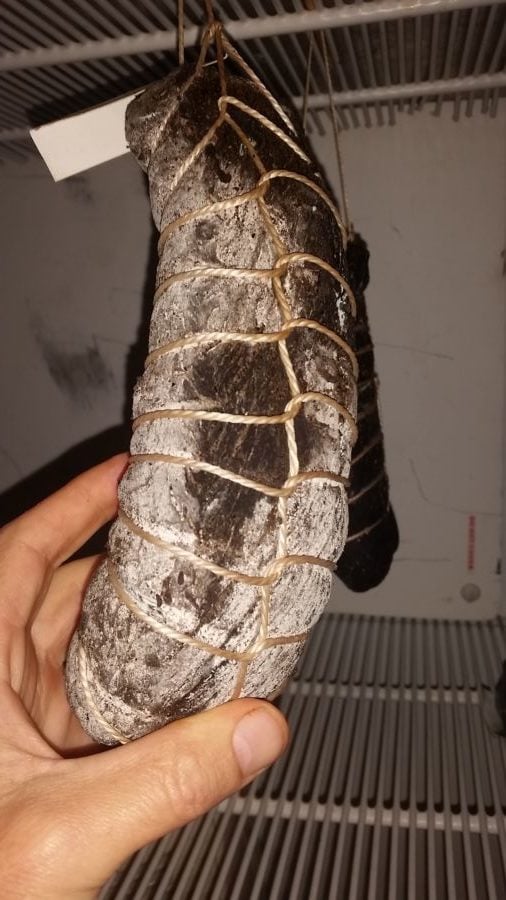
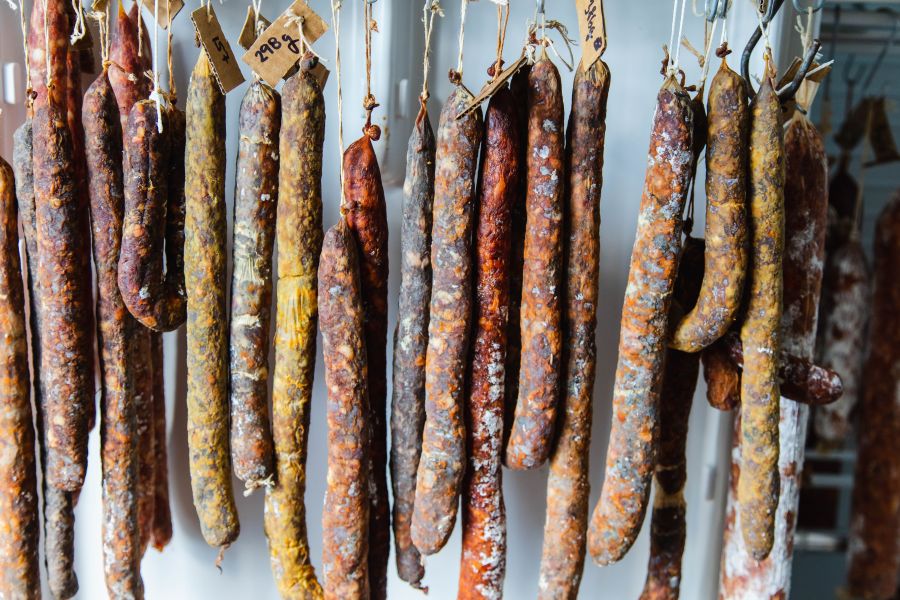
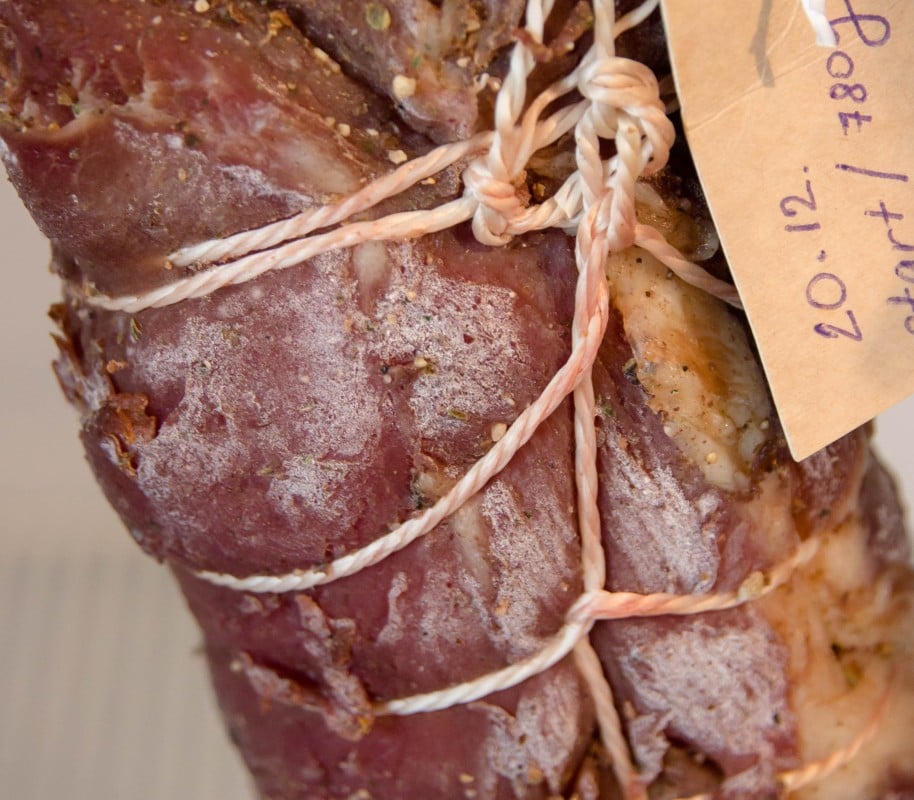
Why Mold Doesn’t Always Appear Right Away
When I started, I didn’t use a starter culture at all. I simply hung the meat and waited to see what nature would do. Often, the mold appeared naturally, especially when I reused the same drying chamber across projects. I’ve seen the same chamber produce new mold blooms without any added culture, just from the existing environment.
This mold is often invisible when it first appears—it’s already present in many cases. It only becomes visible when conditions are right, and it begins to grow.
With experience, you can recognize the early signs and get more consistent results. I now sometimes inoculate new batches with a starter culture (more on that in the next section), but I’ve also had great results just allowing the mold to develop naturally.
How to Introduce Mold for Dry Cured Meats
If beneficial mold doesn’t develop on its own, or you want a more controlled and consistent result, you can introduce a mold culture directly to the meat or into the curing chamber. This is something I do regularly now, especially when working with new chambers or fresh batches of meat.
What Is Mold 600 (Bactoferm)?
The most commonly used commercial mold culture for dry-cured meats is Mold 600, also known as Bactoferm Mold 600. It contains spores of Penicillium nalgiovense, the same white mold that naturally appears on well-aged salami, coppa, or bresaola. It’s used by both home and professional charcuterie makers to get reliable mold coverage and better drying control.
In my experience, Mold 600 helps jumpstart the process and reduces the chance of unwanted molds gaining a foothold. Once introduced, it spreads quickly in the right environment—usually within 3–5 days.
I’ve kept it in my freezer for years, and it still performs well. It can be harder to find in some countries, but if you’re serious about dry curing, it’s worth sourcing.
How I Inoculate My Meats and Chambers
To use Mold 600, I mix about half a teaspoon of the powdered culture with half a cup of water. Ideally, this is distilled water, but I’ve also had good results using filtered water from my bench-top unit.
I shake the container well and then let it sit at room temperature for 6–8 hours. This lets the spores activate. Then, I spray or dab the mixture onto the exterior of the meat. You can also lightly mist the inside of the drying chamber to help the mold take hold across the space.
In just a few days, the meat will start to show early signs of white mold blooming—especially if temperature and humidity are stable. The more balanced your chamber is, the more evenly the mold develops.
Some readers have even written in to ask if scraping mold off store-bought salami works to inoculate new batches. I’ve never done this myself, but in theory, it might seed a chamber with viable spores if done cleanly. I still prefer using Mold 600 for peace of mind and consistency.
Conditions That Promote Beneficial Mold
Whether the mold develops naturally or through inoculation, the environment needs to support its growth. The basic factors are:
Temperature: 50–60°F (10–15°C)
Humidity: 70–80%
Airflow: Gentle but consistent circulation
Lighting: Keep it dark—less light means less risk of fat rancidity
In chambers I’ve built or tested, I always avoid exposing the meat to direct light. I’ve even swapped bulbs for red LED strips or removed them completely. Low light and moderate humidity are key for letting mold thrive while also drying the meat safely.
Cold-smoked meats tend to resist mold development due to the antimicrobial effects of the smoke itself. That’s why bacon and smoked hams often don’t show white mold, even after weeks in the chamber.
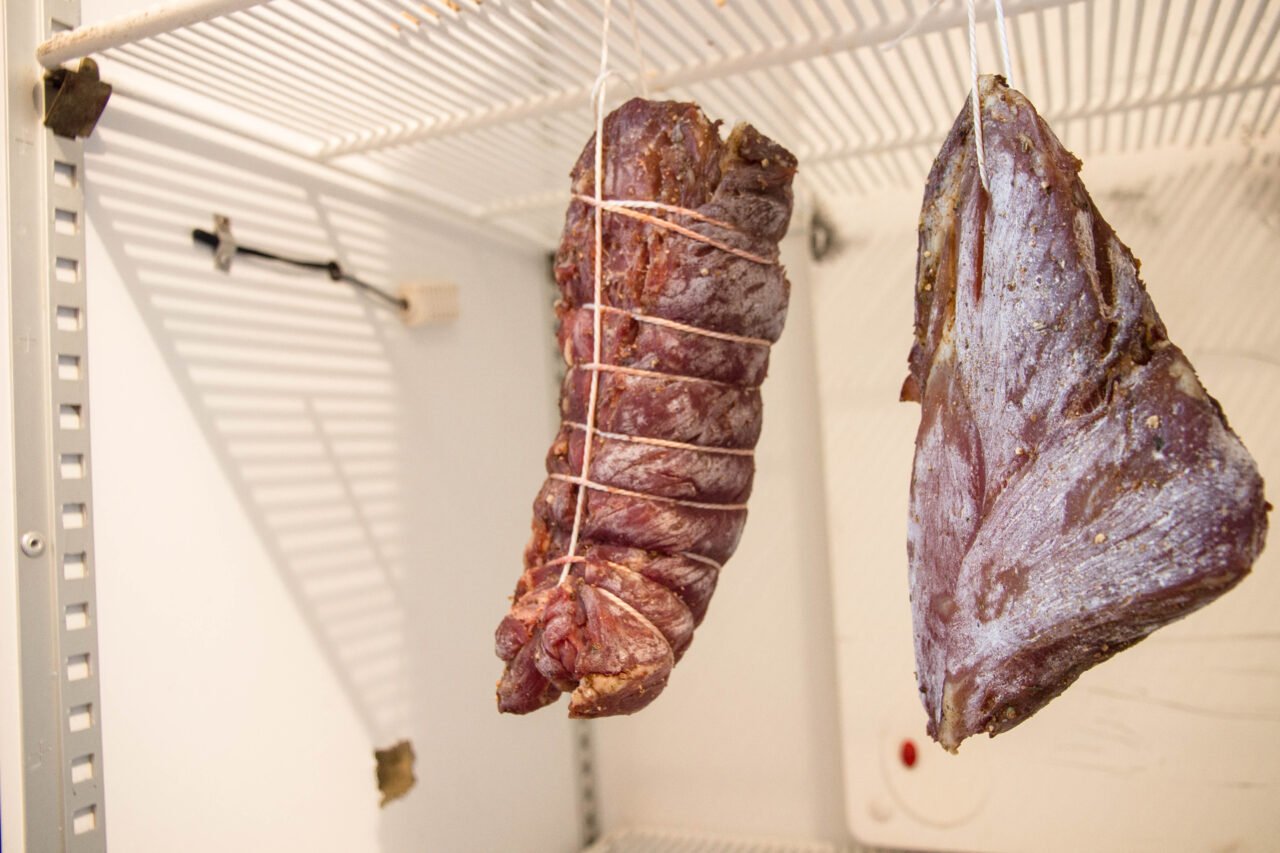
Environmental balance is the foundation for successful dry curing. Even with a strong mold culture, without steady conditions, you’ll either get uneven growth or none at all.
Flavor of Beneficial Molds
One of the lesser-known aspects of beneficial mold is its contribution to flavor. While not everyone eats the mold-covered outer layer of salami or whole muscle charcuterie, I’ve grown to enjoy the subtle umami it can add—especially on smaller, leaner pieces that dry quickly and evenly.
In fact, a friend of mine who now dry cures wild pig guanciale absolutely loves the taste of the white mold layer. It has a mushroomy, earthy quality—kind of like aged cheese rind—that adds real depth when thinly sliced with the fat.
Whether or not you eat the mold is up to you, but the aroma and flavor it imparts during the drying process are noticeable. It’s part of what makes naturally cured meats so complex compared to anything store-bought or quickly fermented.

As your meat dries and the mold matures, the smell evolves. Sometimes you’ll notice mushroomy tones. Other times, a fermented, earthy edge. These are all part of the natural ecosystem working in your favor, if the mold is beneficial and under control.
White Mold Aging Into Green Mold
Many people are surprised to see green mold developing after weeks of drying, even if the meat started with a clean white layer. But this can be a natural progression of the original white Penicillium nalgiovense mold spores.
In my projects, I’ve seen fluffy white mold eventually shift toward a green tinge—especially in chambers that are running longer-term cures. This doesn’t necessarily mean something’s gone wrong. In fact, in the right setting, it can still be part of the beneficial colony.
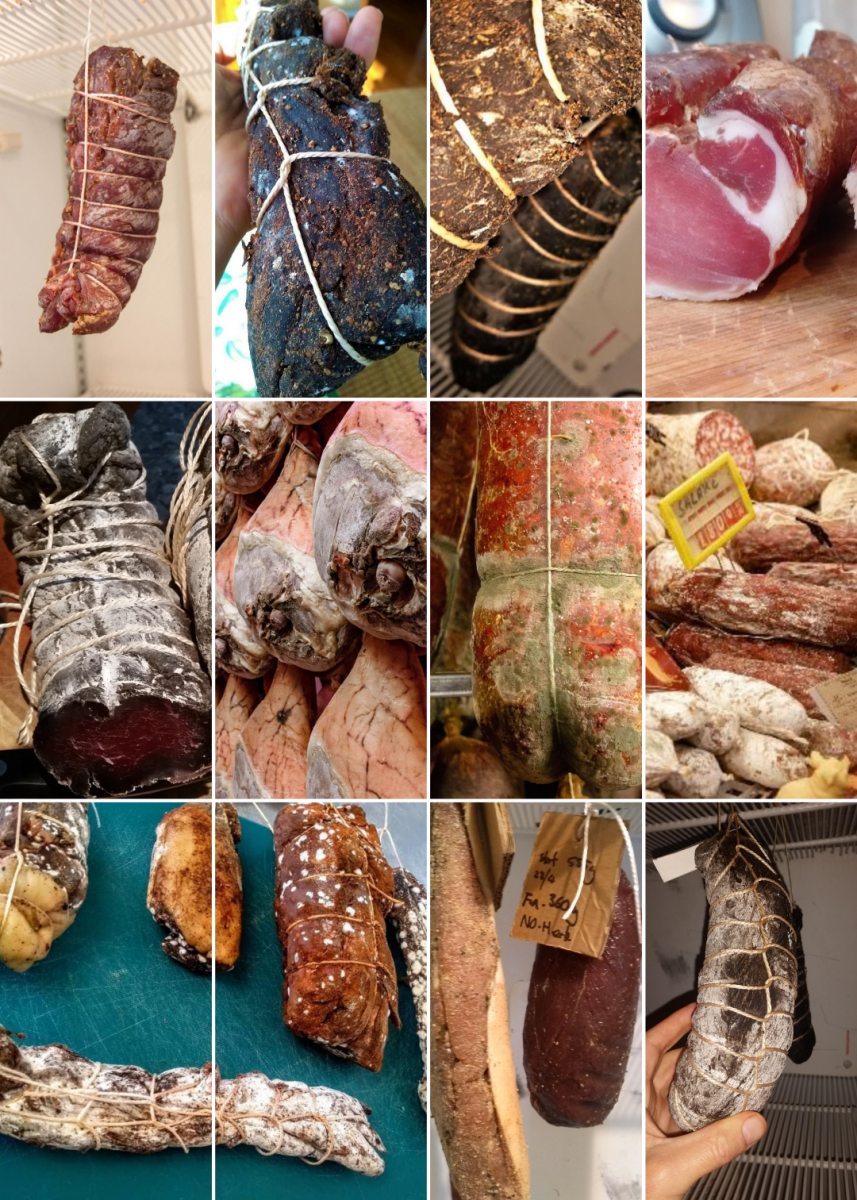
The example above shows several types of desirable mold on different cuts of meat. Each one aged under slightly different conditions, but all with successful outcomes.
These subtle shifts in mold color and aroma are part of the sensory learning curve in dry curing. I get close to each cut and sniff it regularly. A pleasant, mushroom-like smell usually means things are progressing well.
If you’re looking for a better grasp on how the curing process unfolds over time, check out my full guide on how to dry cure meat at home using equilibrium curing. It explains the salting, timing, and moisture loss targets that help mold and meat develop together successfully.
Mold Changes Based on Environment
I’ve had mold disappear temporarily after a power cut reset the chamber to cold fridge temps. I didn’t notice right away, but within a day, the white mold vanished from my hanging Hungarian salami. Once I restored the proper temperature and humidity, it slowly came back again.
These moments helped me realize how closely tied mold development is to the chamber setup. If you’re designing your own chamber, the environmental controls matter just as much as the meat itself. Here’s my detailed breakdown of different meat curing chamber design options I’ve built and tested over the years.
And if you’re looking to source starter cultures like Mold 600, the supplier I use is CHR Hansen, a company that provides mold and bacteria strains to traditional and commercial dry curing producers worldwide. You can read more about them here on their official site.
Managing Mold on Your Cured Meat
Even beneficial molds can sometimes overgrow or drift into unwanted territory. It’s important to keep an eye on mold development and take action when it becomes excessive or suspicious.
Vinegar Wipe Method
A simple 50:50 white vinegar–water solution works wonders to tame mold growth. After wiping the surface with a cloth or soft rag, most mold comes off easily, and the flavor impact is negligible.
After wiping, rehang the meat so the next layer of mold can bloom under controlled conditions. I use this method often when the mold layer gets thick or if I’ve experimented with spices that might affect mold behavior.
Soft Brushing & Cold Smoke
For thicker molds, I start with a sterile, soft-bristle brush to gently remove the bulk. Then, I sometimes follow with a short session of cold smoking (1–3 hours) to help suppress lingering molds and lightly flavor the meat.
I’ve found this combination effective, especially on uncashed whole-muscle cuts where growth can be uneven. After brushing and smoking, I recheck humidity and temperature to give the meat the best chance to rebloom with beneficial cultures.
When Mold Becomes a Concern
Unwanted mold types—especially black, fuzzy, or slimy—must be treated seriously. Black mold often has a wet-looking texture and may give off a distinctly “off” smell.
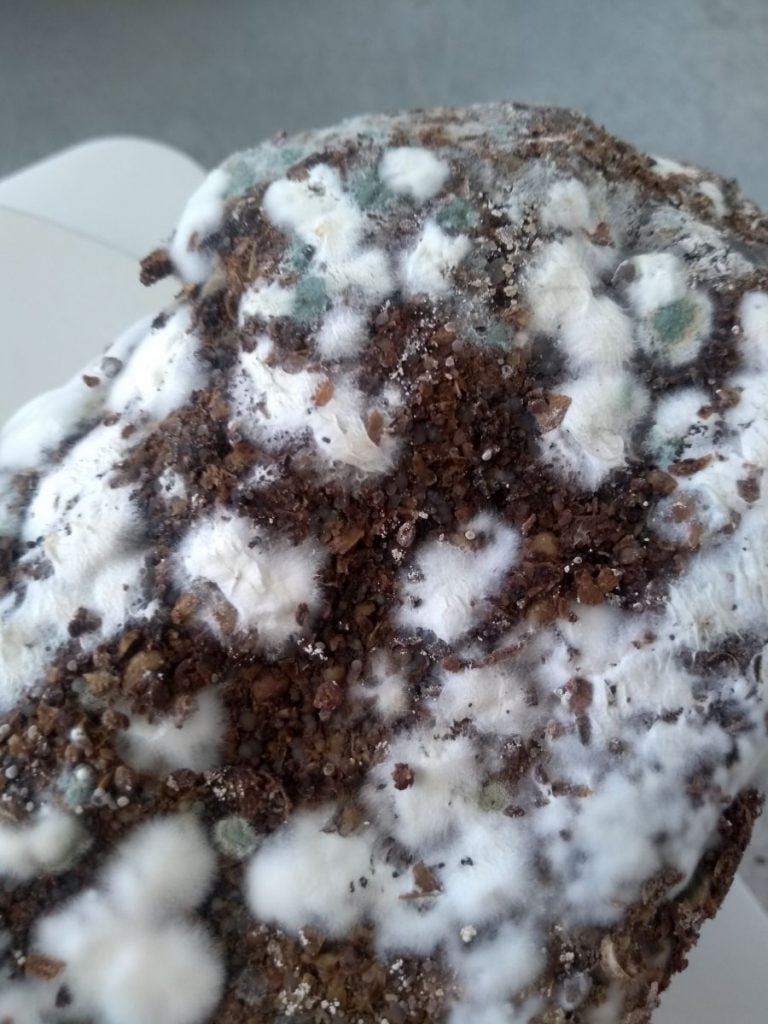
Once you spot this kind of mold, trust your senses. If it smells off—like ammonia, musty cellar, or damp funk—it’s time to discard the meat. I’ve had to throw pieces out only a couple of times after decades of curing, and always err toward safety.
For more insight into how mold changes in colder conditions (and how my Hungarian salami lost its mold after a fridge reset), you can revisit my deep dive on curing meat for long-term storage.
And if you’d like scientific backing on mold culture usage, this PDF from Allied Kenco provides technical details on Mold 600—its safety, handling, and best practices after long-term storage: Mold 600 technical guide.
Expert Tip from Years of Mold Management
Whenever I see mold patterns I’m not sure about, I stop everything and trust my nose first. If I pick up even a hint of something sharp, sour, or chemically “off,” I won’t hesitate to remove that piece, brush it, or wipe it with vinegar. If it still smells strange, I toss it. This simple habit has saved me time and uncertainty more than once, and after decades of curing, I’ve only thrown out two pieces.
One trick that’s helped me spot mold issues early is using no casing on certain cuts. This gives me direct visibility of the surface, so I can act before unwanted mold takes hold. I only recommend this if your chamber is already dialed in and you’re confident managing airflow and humidity.
Alternatives to Mold Management
Instead of encouraging mold growth, some traditional recipes use external coatings to block it entirely. For example, Calabrian pancetta and other Southern Italian styles are often rubbed with cracked black pepper or chili flakes. These ingredients have antifungal and antibacterial properties, which discourage mold from forming during long drying periods.
I’ve used this method with pork belly and even lamb leg—especially when I want to highlight specific spice flavors or keep the outer texture clean. It’s a great option if you don’t have access to mold cultures or want a mold-free finish.
If in doubt, smell it, trust your instincts—and don’t be afraid to start over.
Choosing mold-friendly techniques or mold-blocking spices is a personal decision, but either way, you’re connecting with an ancient craft in a modern way.
Let’s all try to waste less, respect each piece of meat we cure, and stay mindful of how we use energy, packaging, and resources in this process.
If you found this guide helpful, I’ve created a detailed collection of step-by-step dry curing guides that walk through chamber design, salting, humidity, storage, and more. Whether you’re just starting out or scaling up your hobby, there’s something useful in there for every meat curer.
What is the white powdery mold on dry cured meat?
This is typically Penicillium nalgiovense, a beneficial mold that protects the meat while it dries. It helps prevent bad molds from taking hold and improves the flavor and appearance.
Is green mold safe on cured meat?
Some green mold strains are natural and not harmful, especially in traditional chambers. But if it looks fuzzy, wet, or smells off, it’s best to clean it off or discard the meat.
Can I eat cured meat with black mold on it?
No. Black mold may indicate the presence of harmful mycotoxins. It’s safest to discard any meat showing black or dark fuzzy spots.
How do I prevent unwanted mold on cured meat?
Use a clean curing chamber with good airflow, 75–80% humidity, and limited light. You can also inoculate the meat with Mold 600 to control which mold develops.
Have a question or something to share about mold on cured meat? Leave a comment below — I’d love to hear it.
Have a question or your own mold story to share? Drop a comment below — I read every one.
Do you have a question or a mold story to share? Drop a comment below — I read every one.

Tom Mueller
For decades, immersed in studying, working, learning, and teaching the craft of meat curing, sharing the passion and showcasing the world of charcuterie and smoked meat. Read More

Perhaps you can help. I am curing some pepperoni in UMI BAGS. Been in refrigerator since 3/22. It is now 0.71 its original weight. I noticed some white spots with green in the middle of each dot. Should it be discarded? New at this so a bit insecure. Do you have any advice?
Hey there,
often I find white and green completely fine, have a sniff! can wipe with vinegar if you want. You’ll find out when it’s done! Nothing is guaranteed with dry curing, thats why i love it!
I am having the same thing. .79 weight loss using the dry aging bags, and I have a bunch of good white mold showing, but some spots 1/4 inch across that have a grey/green/blue color to them in the center of the dot. If you email me directly, I can send you a pic.
Havent tried those bags, but been talking to some of those companies to see if I can test them. Your Nose will also indicate the molds that you want or not. Wipe with vinegar if its on the outside Cheers Tom
Hello, I’m trying to make my first pancetta. After some time in the fridge, and a few days of my abscense it developed white mold like this:
https://imgur.com/GypQ4He
I asked around and some people told me to wipe it with some vinegar, after the process it looks like this:
https://imgur.com/m8aByb6 https://imgur.com/YkaugKk https://imgur.com/xfmrm1t
I’m not sure about the dark spots, do you think is okay or should i throw it out? The meat itself smells fine.
Best regards
Howdy Jan
Always hard to judge this type of thing from pictures….
How Does it smell? like you want to eat it or not?
What method of curing the meat did you use, eq curing? %’s?, time in cure? how long in cure?
Where was it dried and what temp, humidity and airflow?
how firm was the meat after curing?
There are plenty of cuts/crevices in the meat, did you put dry cure in these?
White mold is of course what you want, so what did that white mold smell like?
It doesn’t look like it has lost 30%+ weight, did it?
I have a course also about whole muscle dry curing here
All the best
T
So just checking we have some speck that was probably stored incorrectly and I think it was sweating now it has white and green mold on the surface and smells funky. Can I was it off and cut the outside and eat it? Or is the smell test saying no?
Hey, I can’t do the smell test for you 🙂 In my experience, white/green like what I show is a good mold. But you have to make the call on that one. People always think dry cured meat belong in fridge, if uncovered the dry environment dries it out fast. If it’s in a container, I have had the same, moisture can create issues.
It best to actually just hang it somewhere around the house in a temperate environment. Like an Italian deli! All the best, Tom
And what about yellow mold
Interesting, email me a pick if you want. But honestly, I haven’t ever got yellow mold. Over the years, many say all is good as long as it’s not black! 🙂 trust your senses! Cheers Tom
Hi Tom,
Thanks for everything you put up her, its so helpful!
I have just got some coppas out of cure and want to briefly cold smoke them before putting them into my maturation chamber. Will the low pH of the smoke permanently stop the growth of mold once the meat is in the chamber or will it just delay it?
Cheers
Hey no worries,
I’ve found, the cold smoke definitely knocks back mold. I recently had cured pork belly/pancetta I decided to cold smoke for 2-3 hours before hanging. But I lay the pork belly on a rack. It didn’t grow nice white mold where the meat was touching the grill and not exposed to the smoke! That was interesting indeed. Dry out for a bit of a pellicle if need be, before cold smoking. Tacky dry outside allows smoke vapor to adhere to it more! Cheers Tom
Hi Tom. Great insight here and I’m just finishing my first batch of salami. The white mold has turned green on a few which I’m ok with but on one or two it’s turned into a pale pinky colour. Doesn’t smell off in anyway. Thinking I should wipe it off and see what it smells like when sliced ? Have you come across this before?
Thanks! What in the recipe? I’ve sometimes got a bit of pinkish kind from humidity being too hight. I just wiped it off with a dap of vinegar! Want to encourage that ‘good’ mold! 🙂 Cheers Tom
Hi Tom, i did a Dry Aged rack of pork and on the outside i noticed some green on the pellicle, i trimmed it off because it was todays deadline 28 days, the colour is promising on the inside but i’m concerned that the mold affected the whole meat. Look foward to hearing your answer.
I am talking cured meats in this post not dry-aged, so meats that are fully salt-cured. I have a dry ager but haven’t tested it out. Watch this space! It has dry curing functionality which I am currently using.
How does it smell? That’s the first thing, if it was smelling ok, I would chop off the green.
In this post, I am talking about advanced penicillin white mold, which is green. Not sure how this relates to dry aging.
Sorry, but dry-aging is not what I do, I wet age wild meat normally like venison.
All the best,
Tom
Hi, I’m not a meat curer! I bought serrano ham last year december ’21! it didn’t get eaten, it was stored dry. Then we cut it but my husband decided he didn’t want it as he was put off by the leg. I then cut it up in January ’23 in smaller pieces and stored them in mylar bags. I went to check on them just now and they have a film of wite mold. I kept it for the dogs, as treats, but not sure now if it’s safe. How long will it kerp and is that slightly slimy white mold safe? ( Iwill scrape it if it hasn’t spoiled the meat) is there another tip how I can find out if the meat is safe? Thank you
Was it vacpacked in the bags? was it stored in a fridge? if yes and yes if yes, i would eat it.
I wouldn’t give much at all to animals since the salt content is a bit high for the poochys
ps. some serranos are dried for 5 years!
Cheers
T
Hey tom its jono from Pici and we picked olives with Jane in puglia i cant find your new number flick me a txt on 0224344519 for a catch up
msged! ciao ! T
Hi Tom. Thank you so much for this article and pictures – incredibly helpful! I am curing my first lonzino and have some fluffy white mold just now starting as I’m at about .75 of original weight. I understand from this that the white fluffy stuff is good, but do I just let it continue to progress or do I wipe it off with vinegar and let it start again? Also, do you typically wipe it all down with vinegar at the end of the cure before vacuum sealing? Thanks so much!
Heya, if its cased, I am not too worried until dried enough. If not cased you could brush it off or wipe it down. always I like to have a sniff and see it the mold smell appealing.
I’ve definitely learnt that taking off the mold with vinegar is best, the mold can change flavors if infused inside the vac pack. All the best, Tom
Hello!
I want to express my gratitude for your assistance—it has been immensely helpful!
I recently cured bresaola and have some reservations about its safety for consumption. Allow me to describe the process and share some pictures:
I began with a 2.1kg piece, trimming some fat, and then divided it into two portions: 1) 960g and 2) 880g.
For the curing, I utilized 500g of sea salt and spices, placing the meat in a zipper bag in the fridge for 7-9 days. During this period, I flipped and massaged it daily. Afterward, I washed it with fresh water, followed by a half cup of red wine and the addition of spices. I then wrapped it in cheesecloth and hung it in the fridge. Around two weeks later, white mold covered most parts, emitting a great aroma. After a month of hanging, I noticed an abundance of green mold alongside the white mold, indicating poor airflow and humidity in the fridge.
*Please copy and paste the url to see the images, Not sure why they are not working as clicks.
1. https://imgur.com/GrquL6h – * Unfortunately, I did not take a picture of my real moldy meat, It looked something like that.
Realizing the issue, I unwrapped it and discovered a fair amount of green mold on the muscle’s surface. I removed it with apple cider vinegar, rewrapped it in a new cheesecloth, and relocated it to a basement with 50% humidity and a temperature of 18-20 degrees Celsius. Approximately two weeks later, the muscle appeared dry without any visible molds. It lost around 40% of its original weight, and though there are no visible molds, there are some stains from the scrubbing process. It smells edible from the outside and delightful from the inside, with no signs of mold.
Ready pictures.
2. https://imgur.com/JkQDetN
3. https://imgur.com/g7MzjjY
4. https://imgur.com/LRUwmXj
After this detailed explanation (sorry about that), I’m seeking your opinion based on your experience. While I understand you can’t guarantee 100% safety, I would appreciate any insights or advice you could provide. What would you do in this situation try eating it maybe fry it or throw it away.
Thank you for your response.
Alex.
Interesting!
You seem to have thoroughly knocked back the mold, looks great, bit drier on the outside then center, I always say trusty your nose, eyes then if you want your mouth! 🙂
Send it to me, if you don’t want it!
Cheers
Tom
Yes, it turned out very dry.
Thanks, It sounds like you would eat it, I will try, and if I don’t reply you’ll know why haha.
Thanks, Tom.
Ah, what a great article! And thank you for the many detailed pictures. I just started learning how to cure/ dry hang and am making Norwegian lamb fenalår. I have a little white fuzzy mold and was worried it was going bad. This put my mind at ease, especially since it’s a whole lamb leg. Haha.
Thank you, again!!
Nice! Thank You. Norwegian flavours are very different! I got a massive Scandinavian cook book from the library and it has some very interesting recipes! All the best, Tom
Hello. Tom. I have read your useful and wonderful writing well.
I’m drying meat, and mold has started to appear. I’m not sure what to do. If it’s harmful, I’ll throw it away, but if it’s harmless, I want to eat it. The problem is I don’t know whether it’s harmful to the body or not. there is no bad odor. but, there is a funky smell.
https://imgur.com/a/CBpKRaL
Thank you for writing such a wonderful post!
Hey there, rub it down with vinegar. I always trust my nose on whether I will eat something or not. Our noses can be very good at telling if something is good or not. All the best, Tom ps. often fuzzy comes from other penniclin based molds, but its always your call.
I made a duck prosciutto with the equilibrium method, cured a couple weeks in the fridge in a vacuum sealed bag, then wrapped in cheesecloth and dried in my mini fridge with a fan, set at 55f and the humidity varied b/w 75-87. I recently cured salami in the fridge with mold 600. I took the duck out every other week and hung in my basement 57f humidity 45-60. When it’d lost 30% I unwrapped it and found some specks of white mold and some dark black patches. It smells fine. I wiped it with vinegar then sliced off the tough dried parts on the meat. It looked bright ruby red underneath the dried dark I cut off. I’ve put it in a vacuum sealed bag in the fridge. I’m concerned about the black spots, which were dry not wet. I have photos but don’t know how to add them to this comment. Any thoughts you have on whether I should eat it or not would be appreciated.
hey there, I go often by smell. in the contact page feel free to email me photos – cheers Tom
tom
I’ve built a curing chamber with all your suggestions and my dried sausage. is at about 30% reduction of weight at the 21-day mark and still have no sign of mold. should I be concerned? my chamber is holding steady at 50 to 55 degrees and 65 to 72 percent humidity. any feedback will be appreciated
anthony
how does it smell?, how does it look?, what is it like when squeezed? I think 30% is minimum, 35-40% is what i aim for minimum for dry cured meat, dried sausage? you mean salami? The factors of how it was made, the binding of the meat, quality of the meat, fermentation quantity of sale or other ingredients wet or dry are all factors. dried salami is often what I say people do after they are comfortable with whole muscle.
Mold occurs naturally on some meat, it can spread to a chamber or not – I’ve had no mold chambers, ok for short term under a few month projects I’ve found. All the best Tom